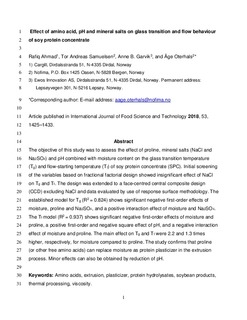| dc.contributor.author | Ahmad, Rafiq | |
| dc.contributor.author | Samuelsen, Tor Andreas | |
| dc.contributor.author | Garvik, Anne B. | |
| dc.contributor.author | Oterhals, Åge | |
| dc.date.accessioned | 2019-04-02T07:25:28Z | |
| dc.date.available | 2019-04-02T07:25:28Z | |
| dc.date.created | 2018-02-19T13:19:50Z | |
| dc.date.issued | 2018 | |
| dc.identifier.citation | International journal of food science & technology. 2018, 53 (6), 1425-1433. | |
| dc.identifier.issn | 0950-5423 | |
| dc.identifier.uri | http://hdl.handle.net/11250/2592817 | |
| dc.description.abstract | The objective of this study was to assess the effect of proline, mineral salts (NaCl and Na2SO4) and pH combined with moisture content on the glass transition temperature (Tg) and flow‐starting temperature (Tf) of soy protein concentrate (SPC). Initial screening of the variables based on fractional factorial design showed insignificant effect of NaCl on Tg and Tf. The design was extended to a face‐centred central composite design (CCD) excluding NaCl and data evaluated by use of response surface methodology. The established model for Tg (R2 = 0.824) shows significant negative first‐order effects of moisture, proline and Na2SO4, and a positive interaction effect of moisture and Na2SO4. The Tf model (R2 = 0.937) shows significant negative first‐order effects of moisture and proline, a positive first‐order and negative square effect of pH, and a negative interaction effect of moisture and proline. The main effect on Tg and Tf was 2.2 and 1.3 times higher, respectively, for moisture compared to proline. The study confirms that proline (or other free amino acids) can replace moisture as protein plasticiser in the extrusion process. Minor effects can also be obtained by reduction in pH. | |
| dc.language.iso | eng | |
| dc.title | Effect of amino acid, pH and mineral salts on glass transition and flow behaviour of soy protein concentrate | |
| dc.type | Peer reviewed | |
| dc.type | Journal article | |
| dc.description.version | acceptedVersion | |
| dc.source.pagenumber | 1425-1433 | |
| dc.source.volume | 53 | |
| dc.source.journal | International journal of food science & technology | |
| dc.source.issue | 6 | |
| dc.identifier.doi | 10.1111/ijfs.13720 | |
| dc.identifier.cristin | 1566564 | |
| dc.relation.project | Norges forskningsråd: 237143 | |
| dc.relation.project | Norges forskningsråd: 242375 | |
| dc.relation.project | Nofima AS: 10874 | |
| cristin.unitcode | 7543,1,3,0 | |
| cristin.unitname | Ernæring og fôrteknologi | |
| cristin.ispublished | true | |
| cristin.fulltext | postprint | |
| cristin.qualitycode | 1 | |
